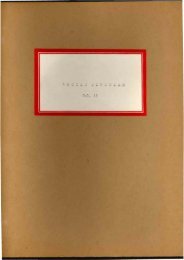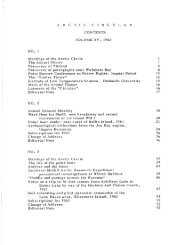Volume 4, 1951 - The Arctic Circle - Home
Volume 4, 1951 - The Arctic Circle - Home
Volume 4, 1951 - The Arctic Circle - Home
You also want an ePaper? Increase the reach of your titles
YUMPU automatically turns print PDFs into web optimized ePapers that Google loves.
<strong>The</strong> Varying Lemming captive in Ottaw8o By T.H. Manning<br />
<strong>The</strong> second number of <strong>Volume</strong> III of the <strong>Arctic</strong><br />
Circular carried a note on four groups of Varying Lemming<br />
brought to Ottawa from the Eastern <strong>Arctic</strong> in 1949. <strong>The</strong><br />
three groups of Dicrostonyx groenlandicus richardsoni from<br />
Churchill are now extinct except for a single indiv!dual at<br />
the National Research Council. <strong>The</strong> last of the 16 captive<br />
D.g. groenlandicus taken at Igloolik died on 29 December<br />
1950, a year and 106 days after capture. ln March the total<br />
known descendants 9f the Igloolik group number 127, of which<br />
50 are still living.<br />
Records of this group have been kept to show the<br />
rate of growth in young lemming and the ages at which they<br />
develop new coats. Some preliminary experiments have also<br />
been made on young animaIs to determine the external factors<br />
causing the change into the white pellage. <strong>The</strong> results<br />
so far obtained indicate that tem~er~tu~e reduction is the<br />
main factor and that the length of exposure to light may<br />
have little or no effect in this speciesn<br />
So far in this group the maximum number to be born<br />
in any one litter is 6. This has occurred only once. <strong>The</strong><br />
greatest number of young produced by any one pair is 43,<br />
these being the result of 12 litters born during the period<br />
between February 19 and November 29, 1950. <strong>The</strong> normal time<br />
between litters is about 23 days, but in the case of the<br />
above pair, there was one gap of 58 days.<br />
"ExercisB Mukluk", designed to test: the latest<br />
types of winter clothing and survival equipment of the<br />
R.C.A.F., R.A.F. a~d U.S.A.F., took place in February.<br />
Eighteen persons ,/'representing the three services mentioned<br />
above, took part in the'Exercise. After spending two weeks<br />
in bush camps in the Fort Nelson region, the group flew to<br />
Cambridge Bay where further tests were made. <strong>The</strong> co-ordinator<br />
of the Exercise was Flight Lt. Scott Alexander of Ottawa.<br />
Plant life in the <strong>Arctic</strong><br />
InnPlant life in the Aretic", published in the<br />
March number of the panadian Geoglaphical Journal, Mr. A.E.<br />
Porsild describes the flora of the various types of arctic<br />
lands cape and the ecology of thesG groups. He outlines the<br />
factors affecting plant growth in tho <strong>Arctic</strong> and then












